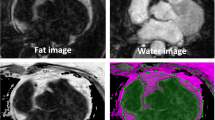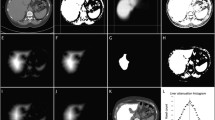Abstract
There is growing evidence that pericardial and epicardial fat volume (PFV, EFV) are associated with cardiovascular risk. We evaluated a novel method for accurate measurement of PFV and EFV using a 3D-Dixon based cardiac magnetic resonance (CMR) approach. An electrocardiography triggered and respiratory navigator gated 3D-gradient echo pulse sequence was used for cardiac Dixon imaging. Based on this sequence, voxels predominantly containing fat were identified and added up for volumetry. After accuracy assessment in phantoms, consisting of muscle tissue and seven different fat samples (50–200 ml), the sequence was acquired in 34 healthy volunteers (22 male, BMI range 14–42 kg/m2, age range 21–79 years) at 1.5 T. Analysis was performed independently by two readers who draw two 3D-regions of interest, one for EFV and one for PFV. Additionally, EFV and PFV were compared between overweighted and non-overweighted subjects. The phantom study showed an excellent agreement of measured and true fat volumes (maximum difference = 6 %, linear correlation coefficient R = 1.00). PFV over all volunteers was 158.0 ± 126.4 ml and EFV was 77.0 ± 55.3 ml. PFV and EFV were highly correlated (R = 0.96). Inter-reader agreement was good with a mean difference of 0.2 ± 5.6 and 4.5 ± 4.2 ml for PFV/EFV, (R > 0.99, each). EFV and PFV differed significantly between subjects with BMI > 25 kg/m2 and BMI < 25 kg/m2, n = 17 each (PFV 219.0 ± 151.8 vs. 96.9 ± 44.7 ml and EFV 102.3 ± 66.3 vs. 51.7 ± 23.6 ml, p < 0.001, each). The proposed 3D-Dixon based method allows accurate measurement of cardiac fat volumes. It provides a valuable tool for cardiovascular risk stratification by CMR.







Similar content being viewed by others
References
World Health Organization (2013) Cardiovascular diseases. World Health Organization, Switzerland, Fact Sheet 317
Dey D, Nakazato R, Li D, Berman DS (2012) Epicardial and thoracic fat—noninvasive measurement and clinical implications. Cardiovasc Diagn Ther 2(2):85–93
Sacks HS, Fain JN (2007) Human epicardial adipose tissue: a review. Am Heart J 153(6):907–917
Iacobellis G, Corradi D, Sharma AM (2005) Epicardial adipose tissue: anatomic, biomolecular and clinical relationships with the heart. Nat Clin Pract Cardiovasc Med 2(10):536–543
Iacobellis G, Pistilli D, Gucciardo M et al (2005) Adiponectin expression in human epicardial adipose tissue in vivo is lower in patients with coronary artery disease. Cytokine 29(6):251–255
Yong HS, Kim EJ, Seo HS et al (2010) Pericardial fat is more abundant in patients with coronary atherosclerosis and even in the non-obese patients: evaluation with cardiac CT angiography. Int J Cardiovasc Imaging 26(Suppl 1):53–62
Dixon WT (1984) Simple proton spectroscopic imaging. Radiology 153(1):189–194
Eggers H, Brendel B, Duijndam A, Herigault G (2011) Dual-echo Dixon imaging with flexible choice of echo times. Magn Reson Med 65(1):96–107
Yu H, Reeder SB, Shimakawa A, Brittain JH, Pelc NJ (2005) Field map estimation with a region growing scheme for iterative 3-point water-fat decomposition. Magn Reson Med 54(4):1032–1039
Bornert P, Koken P, Nehrke K, Eggers H, Ostendorf P (2014) Water/fat-resolved whole-heart Dixon coronary MRA: an initial comparison. Magn Reson Med 71(1):156–163
McConnell MV, Khasgiwala VC, Savord BJ et al (1997) Prospective adaptive navigator correction for breath-hold MR coronary angiography. Magn Reson Med 37(1):148–152
Liu CY, Redheuil A, Ouwerkerk R, Lima JA, Bluemke DA (2010) Myocardial fat quantification in humans: evaluation by two-point water-fat imaging and localized proton spectroscopy. Magn Reson Med 63(4):892–901
Brennan DD, Whelan PF, Robinson K et al (2005) Rapid automated measurement of body fat distribution from whole-body MRI. AJR Am J Roentgenol 185(2):418–423
DuBois D, DuBois EF (1916) Clinical calorimetry: tenth paper: A formula to estimate the approximate surface area if height and weight be known. Arch Intern Med (Chic) XVII(6_2):863–871
Iacobellis G, Willens HJ, Barbaro G, Sharma AM (2008) Threshold values of high-risk echocardiographic epicardial fat thickness. Obesity (Silver Spring) 16(4):887–892
Jeong JW, Jeong MH, Yun KH et al (2007) Echocardiographic epicardial fat thickness and coronary artery disease. Circ J 71(4):536–539
Nyman K, Graner M, Pentikainen MO et al (2013) Cardiac steatosis and left ventricular function in men with metabolic syndrome. J Cardiovasc Magn Reson 15:103
Graner M, Siren R, Nyman K et al (2013) Cardiac steatosis associates with visceral obesity in nondiabetic obese men. J Clin Endocrinol Metab 98(3):1189–1197
Mazurek T, Zhang L, Zalewski A et al (2003) Human epicardial adipose tissue is a source of inflammatory mediators. Circulation 108(20):2460–2466
Rosito GA, Massaro JM, Hoffmann U et al (2008) Pericardial fat, visceral abdominal fat, cardiovascular disease risk factors, and vascular calcification in a community-based sample: the Framingham heart study. Circulation 117(5):605–613
Kukuk GM, Hittatiya K, Sprinkart AM et al (2015) Comparison between modified Dixon MRI techniques, MR spectroscopic relaxometry, and different histologic quantification methods in the assessment of hepatic steatosis. Eur Radiol 25(10):2869–2879
Corradi D, Maestri R, Callegari S et al (2004) The ventricular epicardial fat is related to the myocardial mass in normal, ischemic and hypertrophic hearts. Cardiovasc Pathol 13(6):313–316
Marchington JM, Pond CM (1990) Site-specific properties of pericardial and epicardial adipose tissue: the effects of insulin and high-fat feeding on lipogenesis and the incorporation of fatty acids in vitro. Int J Obes 14(12):1013–1022
Talman AH, Psaltis PJ, Cameron JD, Meredith IT, Seneviratne SK, Wong DT (2014) Epicardial adipose tissue: far more than a fat depot. Cardiovasc Diagn Ther 4(6):416–429
Marchington JM, Mattacks CA, Pond CM (1989) Adipose tissue in the mammalian heart and pericardium: structure, foetal development and biochemical properties. Comp Biochem Physiol B Comp Biochem 94(2):225–232
Fluchter S, Haghi D, Dinter D et al (2007) Volumetric assessment of epicardial adipose tissue with cardiovascular magnetic resonance imaging. Obesity (Silver Spring) 15(4):870–878
Hua N, Chen Z, Phinikaridou A et al (2014) The influence of pericardial fat upon left ventricular function in obese females: evidence of a site-specific effect. J Cardiovasc Magn Reson 16:37
Elming MB, Lonborg J, Rasmussen T et al (2013) Measurements of pericardial adipose tissue using contrast enhanced cardiac multidetector computed tomography–comparison with cardiac magnetic resonance imaging. Int J Cardiovasc Imaging 29(6):1401–1407
Dey D, Suzuki Y, Suzuki S et al (2008) Automated quantitation of pericardiac fat from noncontrast CT. Invest Radiol 43(2):145–153
Yoshizumi T, Nakamura T, Yamane M et al (1999) Abdominal fat: standardized technique for measurement at CT. Radiology 211(1):283–286
Gorter PM, de Vos AM, van der Graaf Y et al (2008) Relation of epicardial and pericoronary fat to coronary atherosclerosis and coronary artery calcium in patients undergoing coronary angiography. Am J Cardiol 102(4):380–385
Nakazato R, Shmilovich H, Tamarappoo BK et al (2011) Interscan reproducibility of computer-aided epicardial and thoracic fat measurement from noncontrast cardiac CT. J Cardiovasc Comput Tomogr 5(3):172–179
Iacobellis G, Assael F, Ribaudo MC et al (2003) Epicardial fat from echocardiography: a new method for visceral adipose tissue prediction. Obes Res 11(2):304–310
Ahn SG, Lim HS, Joe DY et al (2008) Relationship of epicardial adipose tissue by echocardiography to coronary artery disease. Heart 94(3):e7
Mookadam F, Goel R, Alharthi MS, Jiamsripong P, Cha S (2010) Epicardial fat and its association with cardiovascular risk: a cross-sectional observational study. Heart Views 11(3):103–108
Iacobellis G, Willens HJ (2009) Echocardiographic epicardial fat: a review of research and clinical applications. J Am Soc Echocardiogr 22(12):1311–1319; quiz 1417–1318
Ding J, Hsu FC, Harris TB et al (2009) The association of pericardial fat with incident coronary heart disease: the Multi-Ethnic Study of Atherosclerosis (MESA). Am J Clin Nutr 90(3):499–504
Silaghi A, Piercecchi-Marti MD, Grino M et al (2008) Epicardial adipose tissue extent: relationship with age, body fat distribution, and coronaropathy. Obesity (Silver Spring) 16(11):2424–2430
Perissinotto E, Pisent C, Sergi G, Grigoletto F (2002) Anthropometric measurements in the elderly: age and gender differences. Br J Nutr 87(2):177–186
Author information
Authors and Affiliations
Corresponding author
Ethics declarations
Conflict of interest
All authors declare that they have no conflict of interest.
Ethical approval
All procedures performed in studies involving human participants were in accordance with the ethical standards of the institutional research committee and with the 1964 Helsinki declaration and its later amendments or comparable ethical standards.
Informed consent
Informed consent was obtained from all individual participants included in the study.
Rights and permissions
About this article
Cite this article
Homsi, R., Meier-Schroers, M., Gieseke, J. et al. 3D-Dixon MRI based volumetry of peri- and epicardial fat. Int J Cardiovasc Imaging 32, 291–299 (2016). https://doi.org/10.1007/s10554-015-0778-8
Received:
Accepted:
Published:
Issue Date:
DOI: https://doi.org/10.1007/s10554-015-0778-8




